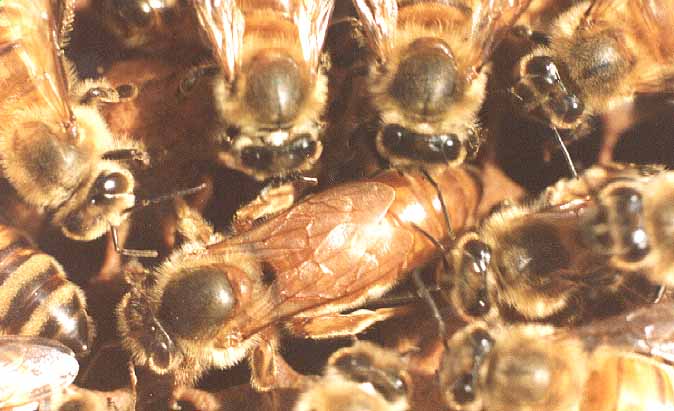
Bee Pheromones
Pheromones are substances secreted by one individual which cause a specific response in other members of the same species.
Bees use pheromones for a number of different communication and behaviour-control purposes. One pheromone may cause many different responses, depending on environmental conditions and pheromone concentration.
Behavioural Pheromones
The pheromone produced by the Nassonoff gland, which opens onto the side of the abdomen, has many purposes, including attracting workers and queens. Conversely,
o-aminoacetophenone is a pheromone produced by virgin queens and released with faeces. In small groups, the pheromone repels and is used when a new queen feels threatened by the workers.
The main
alarm pheromone is released with the sting, and is a mix of many compounds. Benzyl acetate causes only flight behaviour, whereas 1-butanol, 1-octanol, and hexyl acetate cause only the recruitment of more bees from within the hive. Other compounds (1-hexanol, butyl acetate, isopentyl acetate, and 2-nonanol) act in more than one behavioural context.
Marker Pheromones
Honeybees also use Nassonoff gland pheromones for marking food sources, in marking the hive, in scenting prospective hive locations by scouts, and in gathering swarms in flight. Nassanoff gland activity is best seen when a swarm is hived. When a new hive site is found, some bees mark the entrance with a wet, white material from the end of the abdomen. The other bees will then enter. When bees find a new source of food, they also mark it with the same chemical. A powerful marker pheromone is octyl acetate, also found in the sting pheromone.
The odour of each colony is different, and probably results from a combination of endogenous (pheromone or pheromone-like) materials and exogenous (food) materials in each hive. Colonies cannot normally be combined into one hive without the bees fighting and killing one another. Beekeepers usually get round this by placing a newspaper between the two colonies. By the time the bees have eaten through, their odours have mixed and become indistinguishable. During heavy honey flows colonies can be united without difficulty, as the difference in colony odour seems to disappear, or be submerged by the scent of nectar.
Queen Mandibular Pheromone
The queen bee exerts her influence over the hive by means of the Queen Mandibular Pheromone (QMP). This acts as a mating attractant for the drones, and to suppress the reproductive systems of the workers, ensuring that the queen is the only reproductive female in the hive.
QMP contains 9-oxodec-(E)-2-enoic acid, both enantiomers of 9-hydroxydec-(E)-2-enoic acid, methyl para-hydroxybenzoate and 2-(4-hydroxy-3-methoxyphenyl)ethanol.
QMP is only effective in suppressing ovary development in workers when all components are present. Young virgin queens cannot oxidise 9-ODA to 9-HDA, whereas mated queens and older virgin queens can perform this oxidation. QMP is distributed around the hive by food sharing, and as long as the queen substance circulates by this method, the workers know that the queen is present. If the queen is removed, QMP no longer circulates the hive, and the workers begin to feed royal jelly to larvae to produce a new queen. QMP also acts to keep the swarm together when the queen leaves the hive with the swarm.

Worker bee mandibular pheromone contains mainly 10-hydroxydec-(E)-2-enoic acid.